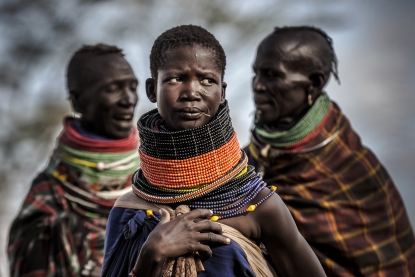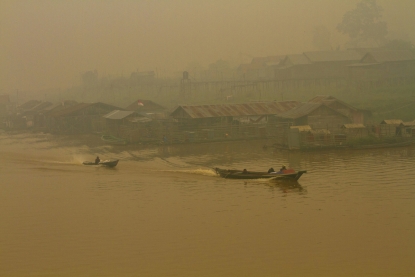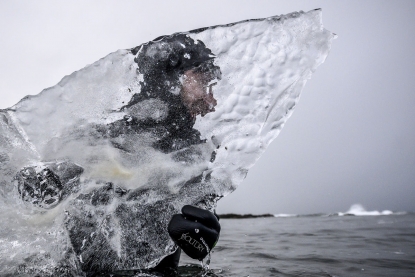Tales from the (climate) edge
As nations huddle in Madrid to try to neutralize the threat of global warming, warnings sound that the Earth is hurtling toward a "point of no return" in the climate crisis, with devastating effects for humanity.
AFP journalists have been on the frontline, documenting climate-related disasters that are becoming deadlier, more frequent and more devastating.
From fires burning out of control in Australia and California, to floods in Africa and Venice. From sinking islands in the US and Asia to orcas going further and further north in search of food. From mingling with scientists at a climate conference to hanging out with Nordic free spirits taking recycling to a new level by chisling a surfboard out of ice so that it melts back into the sea.
The issue of climate change has gained urgency over the past several years and months -- from sick oceans and glaciers near collapse, to teenagers leading worldwide movements to save the planet. As it gains urgency, get a glimpse of the journeys our reporters have taken...
 The board indicating the level of the Mer de Glace glacier in 1990 is pictured in Chamonix on June 17, 2019. (AFP / Marco Bertorello)
The board indicating the level of the Mer de Glace glacier in 1990 is pictured in Chamonix on June 17, 2019. (AFP / Marco Bertorello)As paradise melts and crumbles
Gersende Rambourg
Chamonix, France -- I've come to climb and hike in and around Mont Blanc nearly every year since I was a teenager. With every climb, my love for the mountains has only matured and grown stronger. The silence, the fragile beauty. The warmth of the mountain huts, with their moments of sublime exhaustion and plentitude. During the day, the pleasure of physical exertion. And the joy, every time, of seeing what lies behind the mountain as you climb up to the pass. It’s always another mountain. And it is always glorious.
This summer’s trip, however, was tinged with sorrow, for I went to tell the story of my love slowly dying. Together with AFP’s Italy-based photographer Marco Bertorello, we went to document how climate change is affecting the Mer de Glace, which is disappearing more and more every year.
November 2019
Continue reading here.
 Bangladeshi fishermen walk along the coastline of Kutubdia Island, November, 2015. (AFP / Munir Uz Zaman)
Bangladeshi fishermen walk along the coastline of Kutubdia Island, November, 2015. (AFP / Munir Uz Zaman)
Living on borrowed time
Chris Otton
Kutubdia, Bangladesh -- Since the sea waters first began to rise around the Kutubdia island in Bangladesh three decades ago, washing away entire villages, some 40,000 people have left the area. The remaining 100,000 know that they are living on borrowed time -- with some experts saying that the whole island could be swallowed by the sea in as little as 50 years. And the climate accords reached are unlikely to change much.
December 2015
Continue reading here.
 Four-year-old Parker Shores walks down the middle of the street with his action figure toys in Tangier, Virginia, May 16, 2017, where climate change and rising sea levels threaten the inhabitants of the slowly sinking island.
(AFP / Jim Watson)
Four-year-old Parker Shores walks down the middle of the street with his action figure toys in Tangier, Virginia, May 16, 2017, where climate change and rising sea levels threaten the inhabitants of the slowly sinking island.
(AFP / Jim Watson)A losing battle
Jim Watson
Tangier, Virginia, USA -- Although the island of Tangier has been steadily sinking into the Chesapeake Bay on the eastern coast of the US for years, you’ll find very few climate change believers among its nearly 500-strong population.
Lying about 100 miles (150 kilometers) southeast of Washington DC, the island is estimated to have lost two thirds of its land mass since 1850 -- it’s one of the few places where you can actually see climate change in action. It’s also a place where gender roles are so strictly defined that you feel like you’re stepping back into the 1950. And then there is the language.
July 2017
Continue reading here.
 A burned neighborhood in Paradise, California, November 15, 2018. (AFP / Josh Edelson)
A burned neighborhood in Paradise, California, November 15, 2018. (AFP / Josh Edelson)Paradise gone
Josh Edelson
Paradise, California, US -- Last year, when huge fires ripped through northern California, people thought it was a one-off. We’d had a mega fire and will now go back to regular old wildfires that have been part of life in California for decades. But then Camp came along.
November 2018
Continue reading here.
 A woman balances a load on her head as she crosses a street near India Gate in heavy smoggy conditions in New Delhi on December 6, 2019. (AFP / Jewel Samad)
A woman balances a load on her head as she crosses a street near India Gate in heavy smoggy conditions in New Delhi on December 6, 2019. (AFP / Jewel Samad)Every breath you take
Jewel Samad
New Delhi -- I grew up in one of the most polluted cities in the world. So I thought that I would easily handle New Delhi’s winter, known as pollution season. I thought I was prepared for it. Turns out it’s not something that you can prepare for.
December 2019
Continue reading here.
 Residents defend a property from a bushfire at Hillsville near Taree, 350km north of Sydney on November 12, 2019. (AFP / Peter Parks)
Residents defend a property from a bushfire at Hillsville near Taree, 350km north of Sydney on November 12, 2019. (AFP / Peter Parks)The worst is yet to come?
Peter Parks
Sydney -- Firemen are saying that certain of the bushfires we have in Australia right now will burn for six months. Fires are a natural occurrence in Australia, they happen every year. But this year has been particularly bad...
It’s an accumulation of things I suppose -- we’re in the middle of a drought, there’s no rain, temperatures are rising, there’s excess vegetation that acts as fuel. But all of these have been exacerbated by climate change. Everything is just getting hotter. I’ve been here for five years and I lived here 30 years ago and I’ve never seen it this bad. I’ve never seen Sydney enveloped by smoke from the blazes.
November 2019
Continue reading here.
 A general view shows a man crossing the flooded St. Mark's Square after an exceptional overnight Alta Acqua high tide water level, on November 13, 2019 in Venice. (AFP / Marco Bertorello)
A general view shows a man crossing the flooded St. Mark's Square after an exceptional overnight Alta Acqua high tide water level, on November 13, 2019 in Venice. (AFP / Marco Bertorello)Floods, fashion and freezing in Venice
Ella Ide
Venice -- Wading through freezing, thigh-high water and dodging sewage in the dark was the last thing on my mind as I packed a borrowed Prada outfit and red vintage handbag into my suitcase.
But in journalism you can never take a story for granted -- I had nipped up to Venice for a fashion feature and found myself covering one of the biggest floods in the city's history.
November 2019
Continue reading here.
 Residents gather stranded on the stands of a stadium in a flooded area of Buzi, central Mozambique, on March 20, 2019, after the passage of cyclone Idai. (AFP / Adrien Barbier)
Residents gather stranded on the stands of a stadium in a flooded area of Buzi, central Mozambique, on March 20, 2019, after the passage of cyclone Idai. (AFP / Adrien Barbier)After the storm
Maryke Vermaak
Beira, Mozambique -- If you asked me a few months ago what Mozambique brought to mind, I would have told you the same as many fellow South Africans -- pleasant memories of drinking rum and raspberry soda while lying on a picturesque beach during a summer holiday.
But that was before March, when I flew into the country to cover the aftermath of Cyclone Idai, one of the deadliest storms on record to hit the southern hemosphere that devastated parts of Mozambique and Zimbabwe, killing nearly 1,000 people and impacting more than two million, the vast majority of them in Mozambique.
April 2019
Continue reading here.
 Women belonging to the Turkana community gather next to their village in an arid dry area in Morungole, Turkana County, Kenya, on October 7, 2019. - Turkana is a vast, dry area in the north-west of Kenya that is on the frontline of climate change. With regular searing temperatures the Turkana people are suffering from recurring and prolonged droughts. (Photo by Luis TATO / AFP) (AFP / Luis Tato)
Women belonging to the Turkana community gather next to their village in an arid dry area in Morungole, Turkana County, Kenya, on October 7, 2019. - Turkana is a vast, dry area in the north-west of Kenya that is on the frontline of climate change. With regular searing temperatures the Turkana people are suffering from recurring and prolonged droughts. (Photo by Luis TATO / AFP) (AFP / Luis Tato)Dignity under extremes
Luis Tato
Turkana county, Kenya -- I went to the region to photograph effects of climate change on local communities in far-off Kenyan regions. I ended up documenting dignity.
November 2019
Continue reading here.
 This aerial picture taken on September 16, 2019 shows the thick haze over Palangkaraya, central Kalimantan. - (AFP / Andre)
This aerial picture taken on September 16, 2019 shows the thick haze over Palangkaraya, central Kalimantan. - (AFP / Andre)Smoke gets in your lungs
Sam Reeves
Kuala Lampur -- As I looked out of the window of my apartment in the Malaysian capital Kuala Lumpur last month, the skyscrapers on the horizon disappeared behind vast clouds of acrid, yellow-brown smoke. Across town, the Petronas Twin Towers – the city’s best-known landmark -- were being swallowed by an enormous, fast-advancing bank of toxic smog.
Covering a story is one thing, but finding yourself directly in the middle of it is quite another. Clearly we weren’t as badly affected as others by the smog, but it was still surreal to be writing about all those suffering from it while coughing away at my desk.
October 2019
Continue reading here.
 The Canadian ice-breaker Amundsen in the Canadian Arctic, near the Inuit hamlet of Kugluktuk, Nunavut, Canada on September 20, 2015. (AFP / Clement Sabourin)
The Canadian ice-breaker Amundsen in the Canadian Arctic, near the Inuit hamlet of Kugluktuk, Nunavut, Canada on September 20, 2015. (AFP / Clement Sabourin)Aboard an icebreaker, looking for ice
Clement Sabourin
Aboard the CCGS Amundsen -- Just how is the environment changing above the Arctic Circle? To find out, I boarded the Amundsen, the flagship of the Canadian Coast Guard that acts as a floating laboratory at the forefront of research on global warming. As the icebreaker sailed through the Northwest Passage, the effects of global warming become abundantly clear -- the Amundsen shouldn’t even have made it this far. At this time of the year, this area should have been covered by ice.
September-October 2015
Click to read part one, part two and part three of the series.
 (AFP / Olivier Morin)
(AFP / Olivier Morin)Mesmerized by orcas in the north
Oliver Morin Francois-Xavier Marit
Tromso, northern Norway -- What better way to tell a climate change story than in extreme conditions? With one of the most graceful mammals on the planet and a chance to get great pictures to boot.
Orcas have been moving more and more up north in the fjords of northern Norway, as their main food source in the area -- herring -- migrates further north in search of the cool water that they prefer. We decided to follow them.
March 2019
Continue reading here.
 Swedish surfer Pontus Hallin walks into the water with his ice surfboard partly melted at the Delp surfing spot, near Straumnes, in the Lofoten Islands, over the Arctic Circle on February 18, 2019. (AFP / Olivier Morin)
Swedish surfer Pontus Hallin walks into the water with his ice surfboard partly melted at the Delp surfing spot, near Straumnes, in the Lofoten Islands, over the Arctic Circle on February 18, 2019. (AFP / Olivier Morin)Crazy in the North
Olivier Morin
Staumnes, Norway -- There is a certain Nordic spirit that affects people living in Scandinavia, especially in its northernmost reaches. The crazier the idea, the less likely you’ll give up pursuing it.
Take the ice surfboard as a case in point. The guys who have been regularly surfing in Unstad and Lofoten in northern Norway decided that since they’re in a place where there is ice 10 months out of the year, why not try to make a board out of it?
It sounded like a great way to have some fun. And there was a certain poetic spirit to it all -- as the surfboard melts, the surf returns to the water. Like “ashes to ashes, dust to dust,” but in this case it’s “water to water.” Without the morbid, sad connotations of a funeral service.
April 2019
Continue reading here.
 The sea off the coast of Antofagasta, Chile, July 4, 2013. (AFP / Jorge Jara)
The sea off the coast of Antofagasta, Chile, July 4, 2013. (AFP / Jorge Jara)Climate Change: The ‘Oh Shit!’ moment
Marlowe Hood
PARIS -- It has taken me more than two years to tag & bag the take-away message from my half-decade covering flu pandemics, furtive sub-atomic particles and shrinking ice sheet, and I have Godzilla (along with a movie critic) to thank for the light-bulb moment that brought it all into focus.
For me, a skeptic by nature and training, that thunderclap came while talking to top scientists who had been asked, for a 2009 conference at Oxford, to imagine a world warmed by four degrees centigrade (seven degrees Fahrenheit). What emerged was a tableau of misery bleak beyond words: water wars, climate refugees in the hundreds of millions, galloping disease vectors, wholesale famine. (The 4 C scenario is today considered an ‘intermediate’ projection by century’s end.)
But the real piss-your-pants shocker was realizing that it may be too late to put the hounds of hell back on a leash.
September 2014
Continue reading here.
 This combination of photos shows the Eiffel tower (R) in central Paris through a haze of pollution taken on March 14, 2014 and during clear weather (L) on August 17, 2012. (AFP / Bertrand Guay, Kenzo Tribouillard)
This combination of photos shows the Eiffel tower (R) in central Paris through a haze of pollution taken on March 14, 2014 and during clear weather (L) on August 17, 2012. (AFP / Bertrand Guay, Kenzo Tribouillard)Climate Change: glass half-full or half-empty
Marlowe Hood
Paris -- As a reporter covering climate change, one of the big questions – arguably THE big question – I grapple with is this: are we on the right track to prevent catastrophic global warming? Confronted recently with diametrically opposed answers, I took a deep dive to find out which one was right.
December 2015
Continue reading here.
 A rainbow over Godewaersvelde, northern France, August 16, 2013. (AFP / Philippe Huguen)
A rainbow over Godewaersvelde, northern France, August 16, 2013. (AFP / Philippe Huguen)COP21: Less than meets the eye
Marlowe Hood
Paris -- In a feverish dream last week, I found myself pouring over the final draft of the Paris Agreement moments after the UN presented it for approval to ministers from 195 nations. I frantically looked through the jargon-laden, 32-page climate pact for the silver bullet that would ensure victory in the fight against global warming. Just when I thought I might have found it, I woke up with a jolt.
And so it is, I suspect, for many journalists, analysts, activists and even negotiators embedded in the climate change saga. Six years – more than 20 if one starts the clock with the Rio Earth Summit – of maddeningly Byzantine negotiations, moving sideways or in circles as often as forward, have finally yielded a universal climate accord. But what, many of us are left wondering, has truly been achieved?
A lot.
December 2015
Continue reading here.
 A man walks by a banner announcing the upcoming UN Climate Change Conference, the Cop 21 summit in Paris, on January 14, 2015. (AFP / Jacques Demarthon)
A man walks by a banner announcing the upcoming UN Climate Change Conference, the Cop 21 summit in Paris, on January 14, 2015. (AFP / Jacques Demarthon)The climate logo Rorschach test
Richard Ingham
Paris - Each year, the country that hosts the UN's conference on climate change dishes out a wad of cash on a logo. The usual request to graphic designers is to provide something cosy. Something planetary. You know, we-are-the-worldish.
Whether all the hugginess works is another matter.
January, 2015
Continue reading here.
This compilation was put together by Yana Dlugy in Paris.

